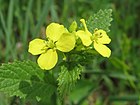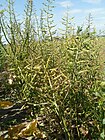Note: This is a project under development. The articles on this wiki are just being initiated and broadly incomplete. You can Help creating new pages.
Difference between revisions of "Sinapis alba - White mustard"
m (Prabhakar moved page Sinapis alba to White mustard (Sinapis alba)) |
(→List of Ayurvedic medicine in which the herb is used) |
||
| (12 intermediate revisions by 2 users not shown) | |||
| Line 1: | Line 1: | ||
| − | + | [[File:Gele mosterd bloemen Sinapis alba.jpg|thumb|right|''White mustard'', ''Sinapis alba'']] | |
| − | + | '''White mustard''' is an annual plant of the family Brassicaceae. It is sometimes also referred to as Brassica alba or B. hirta. Grown for its seeds, mustard, as fodder crop or as a green manure, it is now widespread worldwide, although it probably originated in the Mediterranean region. | |
| − | + | ==Uses== | |
| + | {{Uses|Indigestion}}, {{Uses|Cough}}, {{Uses|Phlegm}}, {{Uses|Tuberculosis}}, {{Uses|Pleurisy}}, {{Uses|Respiratory infections}}, {{Uses|Arthritic joints}}, {{Uses|Chilblains}}, {{Uses|Skin eruptions}}. | ||
| − | + | ==Parts Used== | |
| + | {{Parts Used|Leaves}}, {{Parts Used|Seeds}}. | ||
| − | == | + | ==Chemical Composition== |
| + | Proximate analysis of CM and its fractions revealed carbohydrates as the major component with ash and protein as minor constituents. Glucose was the major monosaccharide present followed by galactose, mannose, rhamnose, arabinose and xylose.<ref name="chemical composition"/> | ||
| − | + | ==Common names== | |
| − | + | {{Common names|kn=|ml=Vella-kadugu|sa=Shvetasarshapa, Siddhartha|ta=Mayirmanikkam|te=Avalu|hi=Safed rai|en=White Mustard, Kedlock}} | |
| − | |||
| − | == | + | ==Properties== |
| + | Reference: Dravya - Substance, Rasa - Taste, Guna - Qualities, Veerya - Potency, Vipaka - Post-digesion effect, Karma - Pharmacological activity, Prabhava - Therepeutics. | ||
| + | ===Dravya=== | ||
| − | + | ===Rasa=== | |
| + | Tikta (Bitter), Kashaya (Astringent) | ||
| + | ===Guna=== | ||
| + | Laghu (Light), Ruksha (Dry), Tikshna (Sharp) | ||
| + | ===Veerya=== | ||
| + | Ushna (Hot) | ||
| + | ===Vipaka=== | ||
| + | Katu (Pungent) | ||
| + | ===Karma=== | ||
| + | Kapha, Vata | ||
| + | ===Prabhava=== | ||
| − | == External Links == | + | ==Habit== |
| + | {{Habit|Annual plant}} | ||
| + | |||
| + | ==Identification== | ||
| + | ===Leaf=== | ||
| + | {{Leaf|Simple|Alternate|Blade coarsely hairy, irregularly pinnately lobed, terminal leaflet large}}<ref name="Leaf"/> | ||
| + | |||
| + | ===Flower=== | ||
| + | {{Flower|Bisexual|1.5 cm|Yellow|5-20|Corolla regular (actinomorphic), yellow, approx and flowering time is July–September}} | ||
| + | |||
| + | ===Fruit=== | ||
| + | {{Fruit|| 2–4 cm|long siliqua terminated by a flat|Densely stiff-haired|many}} | ||
| + | |||
| + | ===Other features=== | ||
| + | |||
| + | ==List of Ayurvedic medicine in which the herb is used== | ||
| + | |||
| + | ==Where to get the saplings== | ||
| + | |||
| + | ==Mode of Propagation== | ||
| + | {{Propagation|Seeds}}. | ||
| + | |||
| + | ==How to plant/cultivate== | ||
| + | Prefers a light well-drained soil[52]. Succeeds on most soils when growing in a sunny position<ref name="How to plant/cultivate"/> | ||
| + | |||
| + | ==Commonly seen growing in areas== | ||
| + | {{Commonly seen|A weed of arable}}, {{Commonly seen|Waste land area}}, {{Commonly seen|Calcareous soils}}, {{Commonly seen|Borders of forests}}. | ||
| + | |||
| + | ==Photo Gallery== | ||
| + | <gallery class="left" caption="" widths="140px" heights="140px"> | ||
| + | 20110703Wildes Rapsfeld Ketsch8.jpg | ||
| + | |||
| + | 20140407Sinapis alba1.jpg | ||
| + | |||
| + | |||
| + | |||
| + | 20110703Rapsfeld Ketsch3.jpg | ||
| + | |||
| + | 20110703Rapsfeld Ketsch4.jpg | ||
| + | |||
| + | |||
| + | 20110703Rapsfeld Ketsch5.jpg | ||
| + | |||
| + | </gallery> | ||
| + | |||
| + | ==References== | ||
| + | |||
| + | <references> | ||
| + | <ref name="chemical composition">[https://www.sciencedirect.com/science/article/pii/030881469390032B "chemical constituents"]</ref> | ||
| + | |||
| + | <ref name="Leaf">[http://www.luontoportti.com/suomi/en/kukkakasvit/white-mustard "plant decsription"]</ref> | ||
| + | |||
| + | <ref name="How to plant/cultivate">[https://www.pfaf.org/user/plant.aspx?LatinName=Sinapis+alba "Cultivation details"]</ref> | ||
| + | </references> | ||
| + | |||
| + | ==External Links== | ||
| + | * [https://www.sciencedirect.com/science/article/pii/S0308814614008425 Sinapis alba on sceince direct] | ||
| + | * [https://www.hort.purdue.edu/newcrop/duke_energy/Sinapis_alba.html Sinapis alba on hort.purdue.edu] | ||
| + | * [http://www.naturalmedicinalherbs.net/herbs/s/sinapis-alba=white-mustard.php Sinapis alba on natural medicinal herbs.net] | ||
| − | |||
[[Category:Herbs]] | [[Category:Herbs]] | ||
| + | [[Category:Ayurvedic herbs that don't have seed photos]] | ||
| + | [[Category:Brassicaceae]] | ||
Latest revision as of 12:51, 13 June 2019
White mustard is an annual plant of the family Brassicaceae. It is sometimes also referred to as Brassica alba or B. hirta. Grown for its seeds, mustard, as fodder crop or as a green manure, it is now widespread worldwide, although it probably originated in the Mediterranean region.
Contents
- 1 Uses
- 2 Parts Used
- 3 Chemical Composition
- 4 Common names
- 5 Properties
- 6 Habit
- 7 Identification
- 8 List of Ayurvedic medicine in which the herb is used
- 9 Where to get the saplings
- 10 Mode of Propagation
- 11 How to plant/cultivate
- 12 Commonly seen growing in areas
- 13 Photo Gallery
- 14 References
- 15 External Links
Uses
Indigestion, Cough, Phlegm, Tuberculosis, Pleurisy, Respiratory infections, Arthritic joints, Chilblains, Skin eruptions.
Parts Used
Chemical Composition
Proximate analysis of CM and its fractions revealed carbohydrates as the major component with ash and protein as minor constituents. Glucose was the major monosaccharide present followed by galactose, mannose, rhamnose, arabinose and xylose.[1]
Common names
| Language | Common name |
|---|---|
| Kannada | |
| Hindi | Safed rai |
| Malayalam | Vella-kadugu |
| Tamil | Mayirmanikkam |
| Telugu | Avalu |
| Marathi | NA |
| Gujarathi | NA |
| Punjabi | NA |
| Kashmiri | NA |
| Sanskrit | Shvetasarshapa, Siddhartha |
| English | White Mustard, Kedlock |
Properties
Reference: Dravya - Substance, Rasa - Taste, Guna - Qualities, Veerya - Potency, Vipaka - Post-digesion effect, Karma - Pharmacological activity, Prabhava - Therepeutics.
Dravya
Rasa
Tikta (Bitter), Kashaya (Astringent)
Guna
Laghu (Light), Ruksha (Dry), Tikshna (Sharp)
Veerya
Ushna (Hot)
Vipaka
Katu (Pungent)
Karma
Kapha, Vata
Prabhava
Habit
Identification
Leaf
| Kind | Shape | Feature |
|---|---|---|
| Simple | Alternate | Blade coarsely hairy, irregularly pinnately lobed, terminal leaflet large |
Flower
| Type | Size | Color and composition | Stamen | More information |
|---|---|---|---|---|
| Bisexual | 1.5 cm | Yellow | 5-20 | Corolla regular (actinomorphic), yellow, approx and flowering time is July–September |
Fruit
| Type | Size | Mass | Appearance | Seeds | More information |
|---|---|---|---|---|---|
| 2–4 cm | long siliqua terminated by a flat | Densely stiff-haired | many | {{{6}}} |
Other features
List of Ayurvedic medicine in which the herb is used
Where to get the saplings
Mode of Propagation
How to plant/cultivate
Prefers a light well-drained soil[52]. Succeeds on most soils when growing in a sunny position[3]
Commonly seen growing in areas
A weed of arable, Waste land area, Calcareous soils, Borders of forests.
Photo Gallery
References
External Links
- Ayurvedic Herbs known to be helpful to treat Indigestion
- Ayurvedic Herbs known to be helpful to treat Cough
- Ayurvedic Herbs known to be helpful to treat Phlegm
- Ayurvedic Herbs known to be helpful to treat Tuberculosis
- Ayurvedic Herbs known to be helpful to treat Pleurisy
- Ayurvedic Herbs known to be helpful to treat Respiratory infections
- Ayurvedic Herbs known to be helpful to treat Arthritic joints
- Ayurvedic Herbs known to be helpful to treat Chilblains
- Ayurvedic Herbs known to be helpful to treat Skin eruptions
- Herbs with Leaves used in medicine
- Herbs with Seeds used in medicine
- Herbs with common name in Hindi
- Herbs with common name in Malayalam
- Herbs with common name in Tamil
- Herbs with common name in Telugu
- Herbs with common name in Sanskrit
- Herbs with common name in English
- Habit - Annual plant
- Index of Plants which can be propagated by Seeds
- Herbs that are commonly seen in the region of A weed of arable
- Herbs that are commonly seen in the region of Waste land area
- Herbs that are commonly seen in the region of Calcareous soils
- Herbs that are commonly seen in the region of Borders of forests
- Herbs
- Ayurvedic herbs that don't have seed photos
- Brassicaceae





